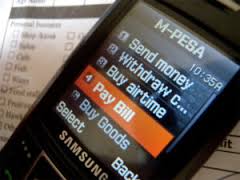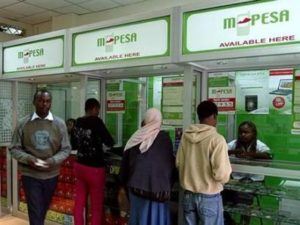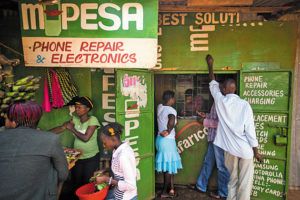M-Pesa: Providing Banking Services to the Unbanked
Revolutionizing banking in Kenya
Kenya Banking Landscape Pre-2007
In 2006, basic banking penetration in Kenya was approximately 19%[1]. Predominately providing banking services from their brick and mortar operations, many Kenya banks found it difficult to service much of Kenya’s rural areas (which comprised a significant percentage of Kenya’s populace). The spending power of rural areas and the perceived nominal services a bank could provide the average client made the provision of banking services through the traditional brick and mortar operations simply uneconomic. At the time, it seemed as if providing banking services to the rural populace would be an unachievable task.
Africa’s Extraordinary Mobile Phone Growth
While the lack of banking services in rural areas continued to persist, something else very significant was occurring on the continent. Africa was witnessing the proliferation of mobile phones (mobile phone penetration in Kenya went from ~28% in 2007 to 88% in 2016[2][3]) in urban and rural areas alike. The growth in mobile telephony and the increased presence and scale of multinational mobile telecommunications companies helped drive increased internet penetration in Africa broadly and in Kenya more specifically. Off the back of the rapid growth in mobile phone use, a business was able to revolutionize the operating model for banking services in the African context.
The Emergence of a New Way of Banking
In 2007, Safaricom, a subsidiary of Vodafone brought to market M-Pesa (‘M’ standing for mobile and Pesa Swahili for money[4]). Known for its convenience, ease of use, and accessibility, M-Pesa enabled money transfers between the most basic mobile phones through SMS. Through M-Pesa’s network of over 40,000 agents (oftentimes individuals or small shops who act as agents to M-Pesa and accept cash and load mobile credit to M-Pesa accounts for clients and vice versa for withdrawals) by the end of 2008 M-Pesa’s payment and money transfer services were used by more than 5 million people[5]. Today, M-Pesa is now used by more than 17 million Kenyans, equivalent to approximately 66% of the adult population. Furthermore, more than 25% of Kenya’s Gross National Product flows through the M-Pesa platform[6]. Since inception, M-Pesa’s platform has grown from a money transfer business to a platform that offers loans and savings products, salary disbursement, and bill payment services.
M-Pesa Opportunities and Threats
Considered by many to be one of the greatest mobile money/mobile financial services success stories in the world, M-Pesa is faced with a number of challenges and opportunities from an operating model perspective:
Opportunities
- Expand Service Offerings to Customers through M-Pesa Platform – Thus far M-Pesa has been used as a means to extend money transfer services, loans and savings products, salary disbursement, and bill payment services to a large segment of consumers who prior to M-Pesa did not have access to the aforementioned services. Having proven concept, M-Pesa must continue to innovate and continue to extend additional financial services through the platform. As an example, Kenya’s insurance penetration rate is estimated to be approximately 3%[7]. Given the de minimis penetration rate in the country, surely M-Pesa has an opportunity to extend insurance products to customers on its platform. Not only will product expansion help to continue to drive customers to the M-Pesa platform but the number of products provided on the M-Pesa platform can help to build barriers to entry that will make competing with M-Pesa overwhelmingly difficult.
- Build Credit Score Capabilities – While M-Pesa has helped consumers gain access to basic banking products, it is well known that credit extension in Kenya has been limited due to the lack of reliable credit scores. At the heart of the flow of capital to and from millions of consumers, M-Pesa has tremendous amounts of data on individual consumers and has the opportunity to think critically about how to turn this data into a useful credit metric that can be appropriately used for the provision of loans. If such a system is created, M-Pesa’s importance to the broader financial infrastructure of Kenya would continue to increase thereby insulating the platform from competition.
Threats
- Disruptive Business Models – While M-Pesa’s success can be largely attributed to its innovative approach to providing banking services, competitors are out in various markets trying to create new products and services that will compete directly with
M-Pesa. Local competitors and external innovations such as bitcoin have the potential to upend M-Pesa’s current competitive advantage. In order to defend itself against ensuing competition, M-Pesa needs to continue to hire appropriate engineering talent that will help the company continue to innovate.
(Words: 777)
[1] https://www.oxfordbusinessgroup.com/overview/further-scope-sector-robust-and-profitable-and-there-are-growth-opportunities-home-and-region
[2] Communications Authority of Kenya, Sector Statistics Report Q2 2008.
[3] Communications Authority of Kenya, Sector Statistics Report Q4 2015-2016.
[4] http://www.forbes.com/sites/danielrunde/2015/08/12/m-pesa-and-the-rise-of-the-global-mobile-money- market/#7584961123f5
[5] http://www.afdb.org/en/news-and-events/article/fostering-financial-inclusion-with-mobile-banking-12125/
[6] http://www.economist.com/blogs/economist-explains/2013/05/economist-explains-18
[7] KPMG Report – Insurance in Africa 2015.






Nichols, this is a very exciting concept and I think it is doing a lot of good to the unbanked populations of the world. I did some research in Mongolia many years ago, and it was incredible to see the pace of change there. Nomadic herders did not go from the desktop, to laptop, to phone like we do. Instead, just like those who use M-Pesa, these people went directly to smartphones. I think for a lot of these populations, it will be hard to drive a credit score, given lack of history and infrastructure. But there are actually companies out there that will find a credit score based on your smartphone usage behavior. For example, how willing phone users are to draining their battery to the last percentage is an indication of their tolerance of risk. I think that is an exciting opportunity for M-Pesa and could certainly drive larger barriers to entry.
Thanks for a great, informative read Nichols. M-Pesa’s far reaching scale in East Africa is incredible. The insurance / credit applications that credit scoring will create will be game changing. As Lawgu2016 mentioned, utilising mobile handset info like charging habits etc. in addition to spending/ fund transfer patterns should be explored. An alternative to developing these capabilities in house could be a acquisition / joint venture with the likes of Shivani Siroya’s Tala. Tala uses data science and machine learning to reach a credit rating for the financially excluded based on over 10,000 data points per customer. I recommend her TED talk if time permits a watch:
A smart loan for people with no credit history (yet)
https://www.ted.com/talks/shivani_siroya_a_smart_loan_for_people_with_no_credit_history_yet
It’s amazing to realize that M-Pesa has really led the industry globally in the field of mobile banking. This is an example of innovation that instead of being created in the west/developing world and trickling up, was actually created on the ground in a developing country and spread to more developed markets over time. When I worked at the World Bank in 2007 we reviewed the dramatic growth of M-Pesa and the market for global remittances (people sending money back to their family via mobile phones). The efficacy and traceability of mobile banking for individuals was revolutionary. People could send money back to their family directly (reminds me of our ITC case) and remove the risk of middle men skimming a profit or withholding the money from their loved ones. A risk that was discussed was the potential for mobile banking to support money laundering and corruption networks given the ease of transferring money. I would assume M-Pesa as its volume of usage has increased has put in controls to prevent their system from being utilized for black market activities but I suspect enforcement would be problematic. As M-Pesa looks to scale this could be a challenge that potential backers/funders would bring up. They would want to have a program in place to reduce this risk.